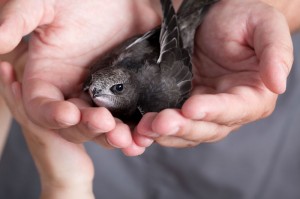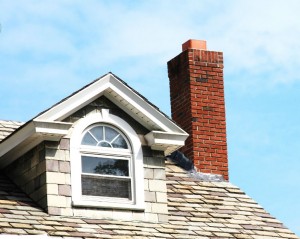by Billy Sweet | Apr 25, 2014 | Uncategorized
Chimney Swifts

These birds are protected by federal law, don’t attempt to remove them yourself.
You may have heard chattering, fluttering, and other noises coming from your chimney and wondered, “Are there birds nesting up there?” Quite possibly, chimney swifts have taken over your chimney as their new home. According to the Driftwood Wildlife Association, chimney swifts are fascinating, adaptable birds who learned to nest and roost in chimneys when their native habitat of large hollow trees in forests of North America were cut down. However, if a family of chimney swifts does nest in your chimney, you should be aware that, according to the Humane Society of the United States, these birds are protected by the Migratory Bird Treaty Act, and removing or destroying nests with eggs or young can result in fines and penalties. Fortunately, the CSIA-certified technicians at Billy Sweet Chimney Sweeps are familiar with the regulations and habits concerning chimney swifts and can work with you on scheduling your annual chimney sweep around the life cycle of the chimney swift as well as fit your chimney with a customized chimney crown to keep the chimney swifts out, if you would rather not share your chimney with these birds.
Protecting These Birds
The Driftwood Wildlife Association formed a special project to promote the conservation of chimney swifts, and they provide valuable information to homeowners through a website, chimneyswifts.org, featuring articles like “Being a Good Chimney Swift Landlord.” With invaluable tips for those who do not mind sharing their chimney with these birds since they do only nest during the summer season, they recommend having your chimney swept in mid-March to have all of the creosote build-up removed, as this makes it impossible for the chimney swifts to build their nests to the walls without danger of falling. The birds make their return from South America after their wintering is over, and as they are migratory, they tend to return to the same nesting area. Like the Humane Society, this article stresses the importance of chimney swifts being protected by federal law and warns against chimney sweep businesses who illegally remove chimney swift nests and eggs. Be wary of companies who advertise “bird removal,” as this is a blatant violation of state and federal laws that protect migratory birds. Instead, choose a company like Billy Sweet Chimney Sweeps, who is active in promoting chimney swift conservation, to perform your annual chimney sweep.
Proper Removal of Their Nests
While the noises of the baby birds chirping for food can be shrill and annoying, they will not last forever. Just keep in mind that this is only temporary, and after that short period, you will rarely know the chimney swifts are there. However, be sure your damper is completely closed to keep them from flying into your house. The nests of these birds are small, cup-shaped constructions of small twigs glued to chimney walls by the birds’ saliva. Too small to be a fire hazard, you will still need to contact Billy Sweet Chimney Sweeps to remove the nest after they leave in the fall. This is needed to remove bird parasites, and since chimney swifts tend to return to the same nest, you do not want them to try to use the old nest as it will be unstable and probably collapse.
If you would like more information about chimney swifts, contact our knowledgeable staff at Billy Sweet Chimney Sweeps. We are happy to answer any questions you may have as well as schedule a chimney sweep for you or a consultation about chimney crown repair.
by Billy Sweet | Mar 5, 2014 | Chimney Maintenance
When the weather warms up, we tend to put our fireplaces and chimney systems out of mind. But before you shut your flue for the season, figuratively and literally, it’s beneficial to consider some spring chimney services that’ll help your chimney come back around to the cold months in the best shape possible.

It’s Springtime! Time to enjoy warm sunny days and let your chimney rest after enduring those cold grueling months of hard labor. Give it some spring chimney care.
So here’s something of a Spring Chimney Care Checklist to go over as your thoughts turn to T-shirts and garden blooms:
Spring Chimney Care Checklist From Billy Sweet Chimney Sweep
Ensure A Clean Chimney And A Non-stinky Spring
If you used your wood-burning fireplace all fall and winter, you doubtlessly have creosote built up in your flue. That’s just part of the equation with burning wood: You get heat, light and creosote. Some folks figure it’s best to just wait until next winter to get the chimney swept, since they’re less concerned about safety and fire hazards when not using the fireplace. But we can make some pretty strong arguments for the benefits of making a chimney sweeping appointment part of your spring chimney care checklist.
First, you’re getting that work done before the busy season, so you’ll have more options in terms of scheduling an appointment with Billy Sweet Chimney Sweep technicians, and most likely a faster turnaround time, too.
More than that, though, you’ll be improving the air in your home all spring and summer. Creosote build-up is one of the most common contributors to a stinky chimney. Creosote has a strong musty smell, and as the temperature and humidity rises, that smell can get stronger. So a spring-cleaned chimney, beyond being ready for winter ahead of time, makes your spring and summer that much more pleasant.
Check For Roof-related Damage
We all know that winter weather can take a toll on our roof, as well as the flashing where the chimney meets the roofline. Before we get into spring rains, it’s good to be aware of any flashing damage, since even something as small as caulking coming off can lead to a chimney leak.
Make Sure Animals Haven’t Moved In, And That They Won’t Be Able To
Some animals — including federally protected chimney swifts — are known for nesting in chimneys during the off-season. And when animals nest in your chimney, they bring along sounds, smells and debris that you certainly don’t want there. Inspecting your flue for nesting animals or signs of nesting animals is a smart thing to do. Preventing nesting animals, by having a quality chimney cap installed, is an even smarter thing to do.
Prep Your Masonry For Moisture
Moisture is, was and always will be the worst friend your chimney has. And during the wetter months, moisture gets a chance to give besting your chimney system’s defenses its all. There’s a lot you can do, though, to protect your system against moisture intrusion, including having Billy Sweet Chimney Sweep inspect your chimney crown and your flashing and having us apply a strong waterproofing sealant to protect your masonry.
You Can Get Through This Spring Chimney Checklist With Billy Sweet’s Help
You can get all of this spring chimney care accomplished — and more — by scheduling a chimney inspection and chimney sweeping appointment with Billy Sweet Chimney Sweep. During an inspection, we’ll check the system bottom to top and let you know if any problems are preventing your chimney from being protected and prepared for the next heating season. Just give us a call to schedule an appointment!
by Billy Sweet | Dec 10, 2013 | Chimney Maintenance
What’s so hot, bright red, and brings a jolly man into your home to deliver gifts to children all over the world? What also can have your whole home in danger within minutes? You got it, your fireplace and chimney. They are made up of many parts that function together to make one working unit. Whether you have a masonry fireplace or a factory-built structure, it is important that you maintain your chimney properly by having an annual sweep and inspection. If you ever have any questions, call up our friends at Billy Sweet Chimney Sweep.

Your chimney works well because all the parts are clean and able to ventilate all harmful gases out and heat in.
Types of Fireplaces
First, you must know what kind of fireplace you have. A masonry fireplace is the more traditional unit, with a firebox built of individual bricks and a brick chimney that sits on top of the roof. These structures are massive and weigh several tons. They will last a long time and require little maintenance other than the recommended yearly inspection. A prefabricated is different in both the materials used and the appearance. They are more modern looking and are built of metal. These units must be installed as they come in their set to not risk being unsafe. These units require much more attention and damage much more quickly.
The Inside of Your Fireplace
Now that you know about the outside of your chimney, let’s get a little deeper and learn about what goes on in the inside. Chimney crowns are important for protection because they eliminate water damage. This is important because when chimneys experience contact with water they can begin to mold or have mortar deterioration, causing the whole structure to begin to weaken. The flue and its liner should be working at top efficiency to make sure that exhaust gases are able to leave the home and reduce any kind of flammable debris from accumulating. The smoke chamber is also important because it is the part of the unit that compresses byproduct of combustion into the smaller space to eliminate any back draft. Chimney dampers help with regulating the electricity, because they make sure you do not lose any energy when the fire is not in use. If you ever find yourself experiencing problems within your chimney you should always call for assistance to make sure there is nothing seriously wrong that could harm you, your family, or your home.



